
Sushi has an abundance of health benefits and tastes amazing but keto sushi options are hard to come by if you don’t know what to order.1
Since keto-approval depends on carb content, we’ll cover sushi options that are low carb, outline a sushi order guide and what to avoid on the keto diet, then explain how to ordera low carb sushi with certain fish, inserts, wraps, and sauces.
In addition to the 8 low-carb ketogenic sushi options we’ve compiled, we’ll also give you several other Japanese keto options to choose from if you’d like to branch out from sushi.
Is Sushi Suitable for Keto Diet?
While some trending diets may prioritize calorie content or added sugars, assessing whether sushi aligns with the keto low carb diet involves checking the carb content in sushi rolls to ensure it stays within the daily carb limit.
One’s daily limit is usually just 20-50 grams of net carbs so it’s vital to pay attention to the nutrition labels of everything consumed.
Not only is the keto diet effective in weight loss, but the role of the ketogenic diet in treating neurological diseases may be very therapeutic as well with a great deal of research supporting this concept.
One such research paper states that the keto diet may aid in prevention or treatment of a multitude of neurological diseases due to decreasing inflammation, restoring myelin sheaths of neurons, aiding in forming and regenerating mitochondrion, and many other drastic health benefits.2
Let’s see if sushi is approved for this low-carb diet.
How Many Carbs Are in Sushi Rolls?
Unfortunately there aren’t pre-made or traditional sushi options that are low-carb as even the lowest carb varieties still pack at least 26 grams of net carbs per serving (1 roll). Although you could potentially enjoy just a piece or two without breaking ketosis, we advise choosing a different entrée much lower in carbs.
The high-carb culprit in sushi is the rice–a single cup of the sushi rice customarily used in Japanese restaurants is about 35 net carbs.
Since traditionally made sushi with rice is unsuitable for keto, the best bet is requesting rice-less sushi to massively decrease carb content and still be able to indulge in sushi.
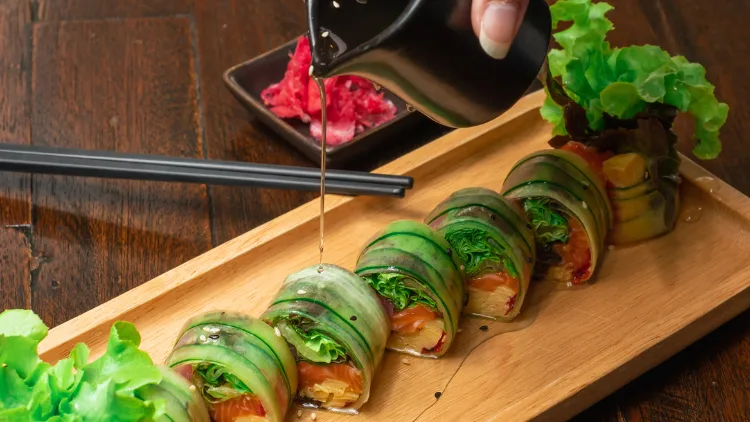
Source: Schwin Pikulsawad via Canva.com3
Since the amount of weight you can lose on keto depends more on maintaining a calorie deficit than solely reducing carb intake, it’s wise to monitor the caloric content of sushi rolls and other meals.
Combining a high-fat, low-carb diet with a caloric deficit can be highly effective, especially when following the 3 steps to lose weight: eating clean, adopting healthy habits, and staying active.
8 Keto Sushi Options (Low Carb Sushi Rolls)
Now that we’ve established that there aren’t any premade sushi options that are ketogenic, we’ll go over some of the lowest carb sushi rolls that can be made into rice-less sushi and help you avoid being bumped out of ketosis.
Despite the inclusion of rice making for non-keto friendly sushi, by opting for no rice sushi rolls you can still reap all of the impressive health benefits of fish and other sushi ingredients and not worry about staying in ketosis.
Thankfully when it comes to nutrition and health regarding keto, researchers at the University of California Davis campus advise that both fish and shellfish can be consumed as much as desired on the keto diet.4
Of course in reality one should still keep track of their carbs, but meats, poultry, eggs, and fish are all very keto-friendly.
Before delving into further health benefits of sushi and fish, let’s cover several keto-friendly sushi varieties that can be ordered without rice.
Spicy Tuna Roll
A plain or spicy tuna roll can be enjoyed on keto as long as it’s rice-less. Rather than adhering to the more extreme tuna diet, keto followers can opt for tuna in their sushi. However, it’s essential to avoid sesame seeds if included, as just one tablespoon contains over 2 grams of total carbs.
With only three ingredients, spicy tuna rolls can be made at home or ordered in a restaurant for a protein-packed sushi option that’s low in carbs.
Commonly Used Ingredients: Nori, Tuna, Sriracha (Optional Avocado or Cucumber)
Taste: Fresh taste with slight tuna flavor and a kick of spiciness
Serving Size: About 3 pieces (100g)
- 140 Calories
- 2g Net Carbs
- 2g Fat
- 28g Protein
Salmon Roll
Another great-tasting sushi choice that is low in carbs is a salmon roll; made with raw salmon, this is one of the most popular types of sushi ordered and for good reason–it tastes amazing. Don’t forget to ask for the chef to exclude the traditionally included rice.
Commonly Used Ingredients: Salmon, Nori, Cucumber, Spicy Mayo or Chili Sauce
Taste: Mild taste, fresher instead of fishy
Serving Size: 3 Pieces (100g)
- 135 Calories
- 1.5g Net Carbs
- 6g Fat
- 21.5g Protein
California Roll (Real Crab)
Another popular choice thankfully falls into our keto-friendly sushi options: the California roll. Since many restaurants use imitation crab for these, remember to request that real crab meat be used instead to save a ton of carbs and maintain ketosis.
This can also be a great option for those trying sushi for the first time or wary of eating raw fish since the crab is fully cooked.
Commonly Used Ingredients: Cooked Crab, Nori, Cucumber, Avocado
Taste: Rich and fresh flavors with the crab taste being the highlight
Serving Size: 3 Pieces (100g)
- 190 Calories
- 3g Net Carbs
- 9g Fat
- 18g Protein
Alaska Roll (Real Crab)
The next of our low-carb sushi options is the Alaska roll that’s made “inside out” with rice on the inside, but since we’re skipping the rice the other ingredients would remain inside while the two proteins–salmon and crab–are wrapped around the exterior. Imitation crab is often used so request real crab as a substitute.
Commonly Used Ingredients: Salmon (Smoked or Raw), Crab, Avocado, Cucumber, Spicy Mayo
Taste: Fresh salmon and crab taste; not overly fishy or too heavy
Serving Size: 3 Pieces (100g)
- 160 Calories
- 0.5g Net Carbs
- 7g Fat
- 22g Protein
Rainbow Roll (Real Crab)
Another of our keto sushi options that typically includes crab is the rainbow roll; again, be sure to opt for real crab instead. Rainbow rolls are similar to the Alaska roll in that they both combine proteins and similar to the California roll as well, except with an extra fish choice.
Rainbow rolls are typically made with crab and another type of fish, as well as several inserts for a complex and stimulating flavor.
Commonly Used Ingredients: Crab, Nori, Cucumber, Avocado, Fish (Tuna, Salmon, Yellowtail, etc.)
Taste: Powerful stimulating flavor, a bolder choice than most other sushis
Serving Size: 3 Pieces (100g)
- 123 Calories
- 3g Net Carbs
- 10g Fat
- 18g Protein
Philadelphia Roll
Philadelphia rolls are a keto-approved sushi option due to their low-carb content and significant fat and protein counts. This sushi type differs from others in that it includes cream cheese and is considered a more Americanized version of Japanese sushi.
Commonly Used Ingredients: Cream Cheese, Smoked Salmon, Cucumber
Taste: Delectable smoked salmon taste with the perfect richness of the cream cheese
Serving Size: 3 Pieces (100g)
- 170 Calories
- 1.8g Net Carbs
- 8.5g Fat
- 8g Protein
Veggie Roll
Vegetable sushi rolls are essentially cucumber rolls with added veggies of choice; these are very healthy and perfectly suitable for vegetarians and vegans.
Commonly Used Ingredients: Nori, Cucumber, Added Veggies of Choice (Carrots, Bell Peppers, Mushrooms, Eggplant, Sweet Potato, Green Onion, etc.)
Taste: Very light, fresh flavor
Serving Size: 3 Pieces (100g)
- 75 Calories
- 1.5g Net Carbs
- 4.1g Fat
- 1.2g Protein
Naruto Roll
Lastly, a “naruto roll” is a sushi roll with a cucumber exterior instead of rice–perfect for our rice-less ketogenic sushi list. As always, be sure to ask your server for real crab and hold off on sugary sauces and use low-carb wasabi or spicy mayo instead.
Commonly Used Ingredients: Sliced Cucumbers, Vegetables, Avocado, Crab (Can Substitute Other Fish)
Taste: Surprisingly great flavor despite the substitutions; the buttery and unique crab flavor combined with the light taste of cucumbers complement each other well
Serving Size: 3 Pieces (100g)
- 110 Calories
- 2.8g Net Carbs
- 3.5g Fat
- 13g Protein
How To Order a Low Carb Sushi (Keto Sushi Options)
Since there aren’t any premade ketogenic sushi rolls, we’ll make sure you’re fully prepared to request a certain substitution or custom made sushi the next time you’re at a restaurant. Check out our tips below for easy ways to order low carb keto sushi.
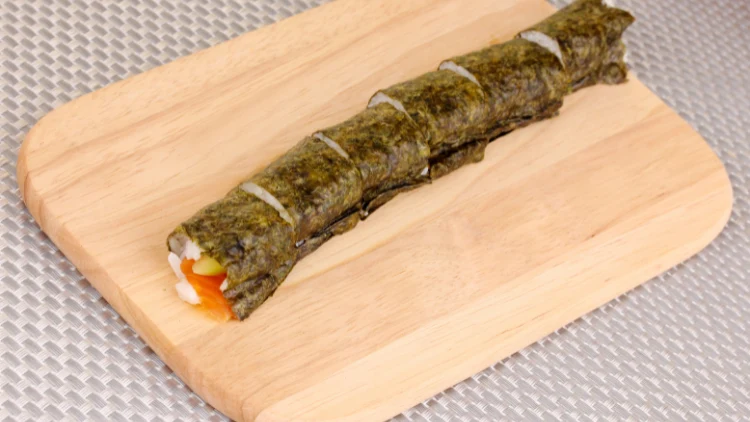
Source: pixelshot via Canva.com5
- Ask for “rice-less” or “no rice” sushi
- Choose your favorite protein (crab, salmon, tuna, eel)
- Pass on the imitation crab as it’s extremely carb-heavy
- Opt for no sesame seeds
- Request a side of wasabi
- Pass on the fried tempura
- Be careful when ordering anything pickled as it may have added sugars
- Choose raw veggies
- Be aware of nutritional value of sauces
- Don’t be afraid to ask your server questions
Low Carb Sushi Order Guide (Keto Sushi Options for Fish, Inserts & Wraps)
Instead of arriving at a Japanese restaurant and scrambling to ask or search on your phone about whether wasabi is keto or the nutrition of specific ingredients, consult our ketogenic sushi options order guide beforehand. This will help you decide what to order, identify low-carb and ketogenic choices, and feel more prepared.
Research has shown that regular fish consumption prevents cognitive decline even when adjusted for age, sex, race, education, and several other factors; the weekly rate of cognitive decline in aging participants was 10% slower in those who consumed at least one meal of fish per week and even more telling–13% slower for those who consumed 2 or more meals of fish per week.6
That being said, check out our list below for which fish options are best to order in your sushi, as well as which wraps, inserts, and sauces have the fewest carbs.
Ketogenic Protein Choices
- Atlantic Mackerel
- Cream Cheese
- Edamame
- Eel
- Real Crab
- Salmon
- Squid
- Tuna
Keto-Friendly Inserts
- Avocado
- Bean Sprouts
- Bell Pepper
- Cauliflower
- Coconut
- Cucumber
- Green Onion
- Lemon
- Lettuce
- Olives
- Radish
- Tomato
Keto-Approved Wraps
- Cauliflower Rice
- Cucumber
- Seaweed Wraps (Nori)
- Soy Paper
Best Sauces for Keto
- Fish Sauce
- Ponzu Sauce (In Moderation)
- Regular Soy Sauce
- Spicy Mayo
- Sriracha
- Tamari
- Wasabi (In Moderation)
Which Sushi Rolls & Sides To Avoid on the Ketogenic Diet
After covering plenty of options for including in your low carb sushi, let’s review which sushi rolls and sides to avoid on the ketogenic diet to ensure you can enjoy your meal without being concerned you’ll be kicked out of ketosis. Other than going with rice-less sushi, pass on anything fried, starchy, or high in added sugars as well.
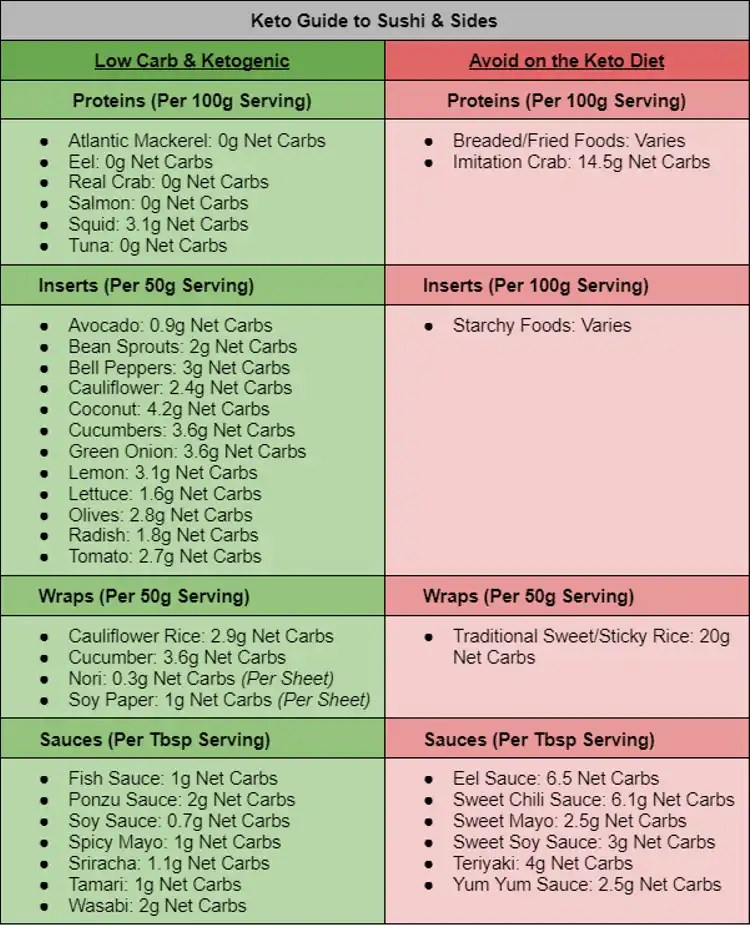
Proteins to Avoid on Keto
- Breaded or Fried Proteins
- Imitation Crab
Non-Keto Sushi Inserts
- Starchy Foods
- Sweet Rice
Skip These Sauces
- Eel Sauce (Unagi)
- Sweet Chili Sauce
- Sweet Mayo
- Sweetened Soy Sauce
- Teriyaki Sauce
- Yum Yum Sauce
Sushi Health Benefits
Sushi and most of the common fish and vegetables included in sushi rolls are extremely healthy and offer many potential benefits.
To begin, both fatty fish consumption and autoimmune disease were examined in a Swedish case-controlled study and the findings indicated that fatty fish consumption may play a role in reduction of latent autoimmune disease presenting in adulthood. The researchers speculated that this might occur due to the impacts of marine-originated omega-3 fatty acids.7
Another study on the health benefits of omega-3 fatty acids supported this concept of omega-3s offering great benefits and the UK dietary guidelines for cardiovascular disease have even acknowledged the ability of these fish oils to reduce heart disease.8
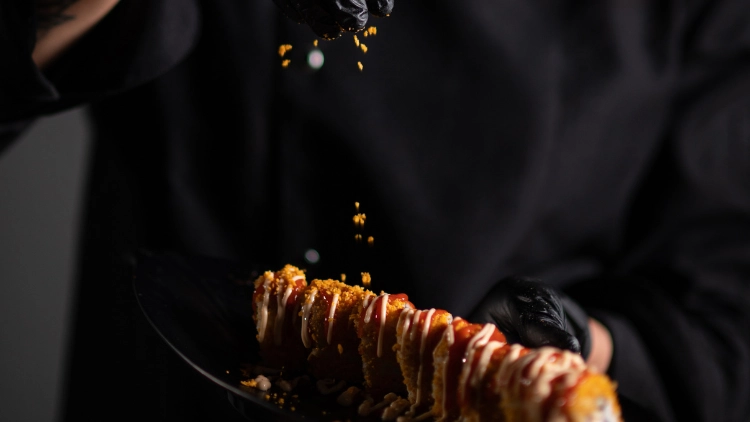
Source: ilkermetinkursova via Canva.com9
In addition to the health benefits of sushi–or the fish used in sushi–even wasabi has its own impressive set of benefits that can be reaped when enjoying sushi. As long as you don’t mind the kick, regarding wasabi the antiplatelet and anticancer properties of wasabi were studied by researchers and the results indicated that Japanese domestic horseradish or “wasabi” may even prevent cancer cells from forming.10
With so many incredible benefits and being ketogenic if ordered without rice, sushi is a great go to option on the keto diet.
Alternative Japanese Keto Options
Besides covering the best sushi for keto, we want to go a step further and provide a few more choices for what’s keto at sushi restaurants. For anyone curious about losing weight fast without exercise in a month, opting for low-carb keto-approved dishes and sides is an excellent way to begin.
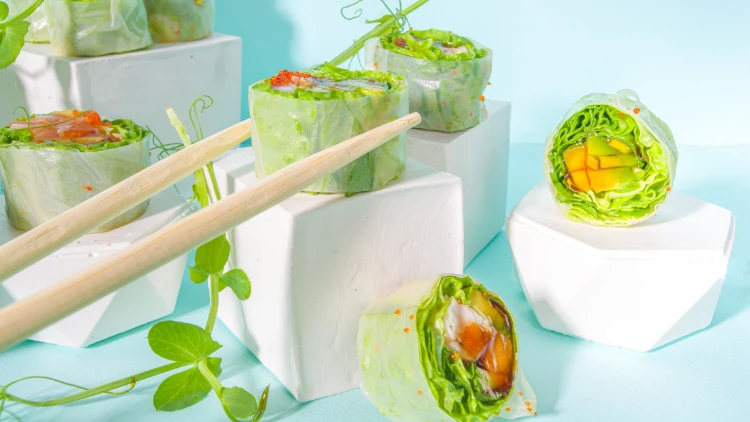
Source: rimmabondarenko via Canva.com11
Beef or Chicken: Dishes with either beef or chicken should be fine as long as they’re not smothered in teriyaki or another sweet sauce that can quickly add sugar or carbs.
Miso Soup: A warm, savory and delicious soup, miso is a traditional Japanese staple that’s often served as an appetizer and is very keto-friendly. Miso often includes vegetables such as onions and cabbage.
Tofu can be added as well if desired.
Sashimi: Typically the lowest carb item served in most Japanese restaurants, sashimi is different from sushi in that it comes without any rice. Sashimi is the name of thinly sliced or cubed cuts of raw fish or seafood (or sometimes other meats) and is often served with soy sauce, lemon, wasabi, or other sauces.
As long as the sauce is ketogenic, sashimi is very safe for this diet.
Shrimp: Shrimp is not only beneficial for weight loss but also perfectly suitable for keto, containing just 0.2g net carbs per 100g serving. It’s also high in calcium and protein and can be enjoyed on keto along with the previously listed fish options.
Temaki: “Temaki” is the name given to rice-less hand rolls–essentially sushi ingredients (minus rice) inside of a cone of seaweed. Be sure to request real crab if the restaurant typically makes their temaki with the imitation variety.
Though regrettably there aren’t any pre-made sushi rolls that are ketogenic, by skipping the rice you can easily order plenty of keto sushi options or use our guide to build your own low carb sushi at home.
Frequently Asked Questions
What Are the Top 3 Keto Friendly Sushi Options With the Fewest Carbs?
Our votes for the best 3 low-carb keto sushi rolls go to Alaska, Salmon, and Veggie rolls with 0.5g, 1.5g, and 1.5 grams of net carbs respectively.
Is Soy Paper Keto? How Many Carbs in Soy Paper?
Those trying to decide what type of sushi wrap to use while following the ketogenic diet are likely asking the following questions: is soy paper keto? How many carbs in soy paper? Thankfully soy paper is keto-friendly with just 1g net carbs per sheet.
How Many Carbs in Nori Seaweed Wraps?
Nori seaweed wraps actually have even fewer net carbs than soy paper (which is also keto-approved) with a mere 0.3g net carbs per sheet.
Which Types of Sushi Should I Avoid on Keto?
When it comes to sushi, keto guidelines unfortunately don’t accommodate all sushi types due to some being way too carb-heavy to fit within the daily keto carb limits.
Crunchy california rolls and anything else with tempura fried or breaded ingredients should be avoided, as well as sesame seeds and sweet sauces that add both sugar and carbs.
References
1iconogenic. “Woman Eating Sushi.” Canva. Accessed 22 April 2023. <https://www.canva.com/photos/MAEEjFFzOqE-woman-eating-sushi/>
2Dynka, D., Kowalcze, K., & Paziewska, A. (2022, November 24). The Role of Ketogenic Diet in the Treatment of Neurological Diseases. Nutrients, 14(23), 5003. <https://www.ncbi.nlm.nih.gov/pmc/articles/PMC9739023/>
3Pikulsawad, Schwin. Canva. Accessed 22 April 2023. <https://www.canva.com/photos/MAElyDvSP8w-maki-roll-without-rice-japannese-fusion-food-/>
4UC Davis Department of Nutrition. (2020, December 4). Nutrition & Health Info Sheets for Health Professionals – The Ketogenic Diet. University of California, Davis. Retrieved March 11, 2023, from <https://nutrition.ucdavis.edu/outreach/nutr-health-info-sheets/pro-ketogenic-diet>
5pixelshot. Canva. Accessed 22 April 2023. <https://www.canva.com/photos/MAD_UNPXRgY-making-rolls/>
6Morris, M., Evans, D., Tangney, C., Bienias, J., & Wilson, R. (2005, October 10). Fish consumption and cognitive decline with age in a large community study. Archives of Neurology, 62(12), 1849-1853. <https://pubmed.ncbi.nlm.nih.gov/16216930/>
7Lofvenborg, J., Andersson, T., Carlsson, P.-O., Dorkhan, M., Groop, L., Martinell, M., Tuoni, T., Wolk, A., & Carlsson, S. (2014, October 20). Fatty fish consumption and risk of latent autoimmune diabetes in adults. Nutrition & Diabetes, 4(20), e139. <https://www.ncbi.nlm.nih.gov/pmc/articles/PMC4216999/>
8Ruxton, C., Simpson, M., & Mulligan, K. (2004, October). The health benefits of omega-3 polyunsaturated fatty acids: a review of the evidence. Journal of Human Nutrition and Dietetics, 17(5), 449-459. <https://pubmed.ncbi.nlm.nih.gov/15357699/>
9ilkermetinkursova. Canva. Accessed 22 April 2023. <https://www.canva.com/photos/MAFdEdNpGIM-female-sushi-chef-making-roll-sushi/>
10Morimitsu, Y., Hayashi, K., Nakagawa, Y., Horio, F., Uchida, K., & Osawa, T. (2000). Antiplatelet and anticancer isothiocyanates in Japanese domestic horseradish, wasabi. Biofactors, 13(1-4), 271-276. <https://pubmed.ncbi.nlm.nih.gov/11237193/>
11rimmabondarenko. Canva. Accessed 22 April 2023. <https://www.canva.com/photos/MAEZrMr5THw-sushi-without-rice-spring-rolls/>